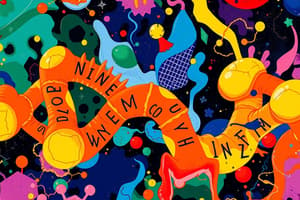Podcast
Questions and Answers
Enzymes are biological catalysts that can be used up in chemical reactions.
Enzymes are biological catalysts that can be used up in chemical reactions.
False (B)
Pepsin operates best at a pH of 10.
Pepsin operates best at a pH of 10.
False (B)
Co-enzymes are organic, non-protein molecules that help enzymes function.
Co-enzymes are organic, non-protein molecules that help enzymes function.
True (A)
Enzymes maintain their shape and activity at all temperature levels.
Enzymes maintain their shape and activity at all temperature levels.
Most enzymes work best at a neutral pH around 7.
Most enzymes work best at a neutral pH around 7.
The optimal temperature for plant enzymes is generally lower than for human enzymes.
The optimal temperature for plant enzymes is generally lower than for human enzymes.
Denatured enzymes have increased activity and efficiency.
Denatured enzymes have increased activity and efficiency.
Enzyme activity increases with temperature up to around 40^o^C.
Enzyme activity increases with temperature up to around 40^o^C.
Albumen begins as a clear runny jelly and becomes stiff and white when denatured.
Albumen begins as a clear runny jelly and becomes stiff and white when denatured.
Salivary amylase continues to digest starch in the stomach due to the acidic environment.
Salivary amylase continues to digest starch in the stomach due to the acidic environment.
Agitation, such as shaking or beating, can denature enzymes.
Agitation, such as shaking or beating, can denature enzymes.
The optimum pH for salivary amylase is around pH 1.
The optimum pH for salivary amylase is around pH 1.
In an anabolic reaction, the products are more complex than the reactants.
In an anabolic reaction, the products are more complex than the reactants.
Enzymes retain their original shape after forming a substrate-product complex.
Enzymes retain their original shape after forming a substrate-product complex.
Benzoic acid can preserve soft drinks by degrading enzymes in bacteria and fungi.
Benzoic acid can preserve soft drinks by degrading enzymes in bacteria and fungi.
Flashcards
Enzymes
Enzymes
Proteins that accelerate chemical reactions without consumption.
Substrate Specificity
Substrate Specificity
Each enzyme is specific to one substrate and product set.
Co-enzymes
Co-enzymes
Organic, non-protein molecules that assist enzymes.
Factors Affecting Enzymes
Factors Affecting Enzymes
Signup and view all the flashcards
Optimal pH
Optimal pH
Signup and view all the flashcards
Temperature Effects
Temperature Effects
Signup and view all the flashcards
Denaturation
Denaturation
Signup and view all the flashcards
Active Site
Active Site
Signup and view all the flashcards
Enzyme-Substrate Complex
Enzyme-Substrate Complex
Signup and view all the flashcards
Anabolic Reactions
Anabolic Reactions
Signup and view all the flashcards
Catabolic Reactions
Catabolic Reactions
Signup and view all the flashcards
pH Effects on Amylase
pH Effects on Amylase
Signup and view all the flashcards
Enzyme Denaturation (Temperature)
Enzyme Denaturation (Temperature)
Signup and view all the flashcards
Enzyme Denaturation (pH)
Enzyme Denaturation (pH)
Signup and view all the flashcards
Enzyme Agitation
Enzyme Agitation
Signup and view all the flashcards
Study Notes
Enzymes Overview
- Enzymes are proteins that act as biological catalysts, accelerating chemical reactions without being consumed.
- Each enzyme is specific to one substrate and produces only a specific set of products.
- Made from long chains of amino acids linked by peptide bonds; their structure is folded into a unique 3D shape.
Co-enzymes
- Some enzymes require additional molecules, known as co-enzymes, for optimal function.
- Co-enzymes are organic, non-protein substances; vitamins B1 and B6 function in this role.
- Enzyme names typically end with the suffix ‘-ase’.
Factors Affecting Enzyme Activity
- Enzyme function is influenced by environmental conditions such as pH, temperature, concentration of enzymes, and substrates, as well as the presence of inhibitors.
pH Impact
- Each enzyme has a specific pH range for optimal activity:
- Amylase: best at pH 7 (neutral).
- Pepsin: functions optimally around pH 2 (acidic), suited for the stomach.
- Lipase: works best at pH 10 (alkaline) in the small intestine.
Temperature Impact
- Enzyme activity typically increases with temperature, peaking at around 40°C.
- Above 40°C, enzymes rapidly denature, losing shape and function.
- Human enzymes function optimally around 37°C but can become inactive above this temperature, particularly in the brain, risking seizures.
- Plant enzymes thrive at an approximate optimum temperature of 25°C.
Denatured Enzymes
- Denaturation refers to the loss of an enzyme's shape and activity, caused by several factors:
- High Temperature: Enzymes lose shape above 40°C; irreversible changes occur at temperatures exceeding 50°C. For example, egg whites transition from clear to stiff upon heating.
- pH Change: For instance, salivary amylase, which breaks down starch at pH 7-8 in the mouth, becomes inactive when exposed to the acidic environment (pH 1) in the stomach.
- Agitation: Physical mixing or beating can alter enzyme shape and activity, such as when egg whites are beaten, forming a thick mixture that traps sugar.
Active Site Theory
- The active site is the specific region on the enzyme where the substrate binds and reactions occur.
- The binding causes slight shape changes in both substrate and enzyme, forming an enzyme-substrate complex.
- These transformations facilitate product formation and lower activation energy needed for the reaction.
- Resulting products may form a substrate-product complex, allow the enzyme to revert to its original shape, ready to catalyze another reaction.
Types of Reactions
- Anabolic Reactions: Create more complex products from simpler reactants; e.g., muscle formation.
- Catabolic Reactions: Break down complex reactants into simpler products; oppositely, they release energy.
Studying That Suits You
Use AI to generate personalized quizzes and flashcards to suit your learning preferences.





